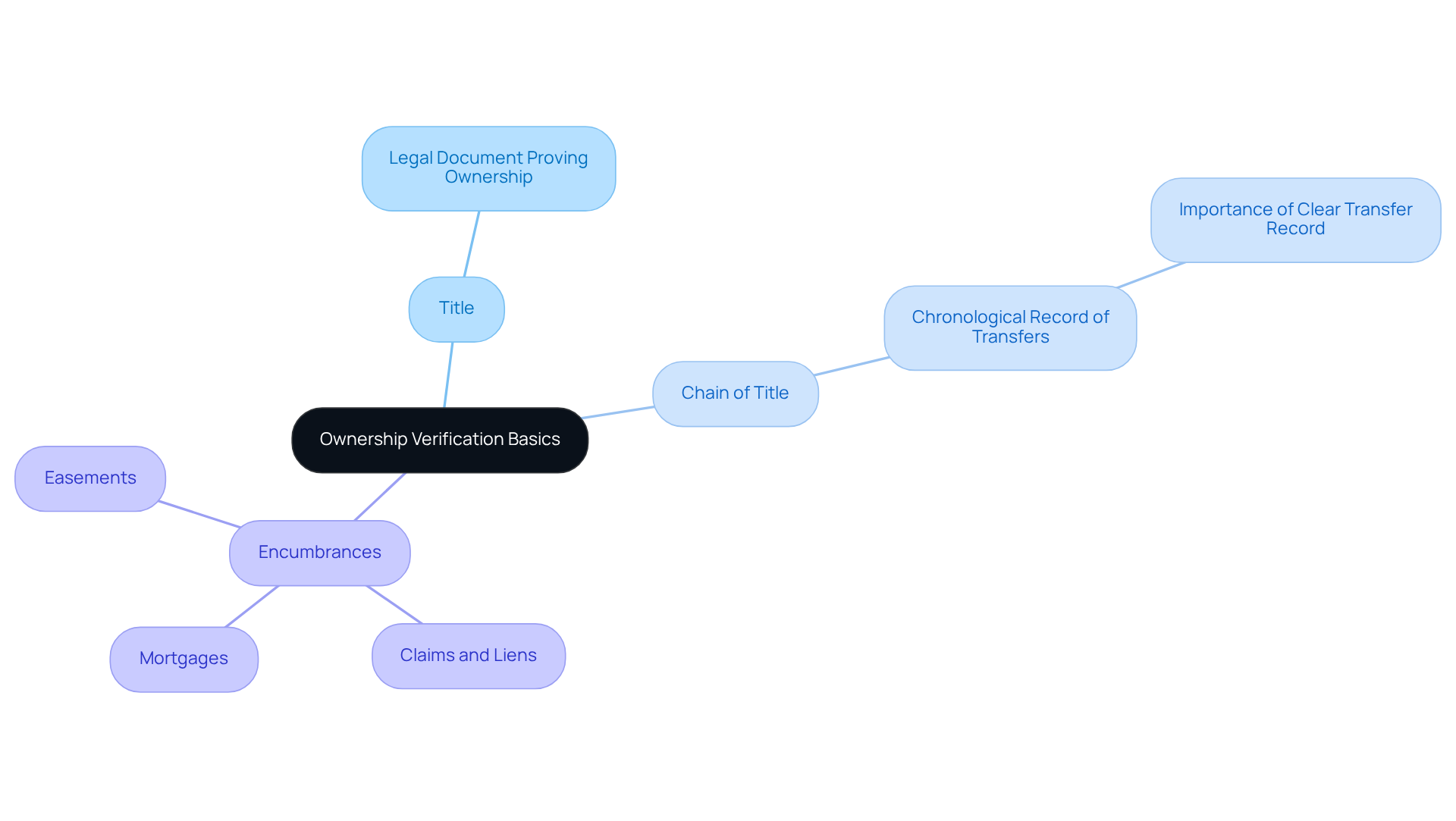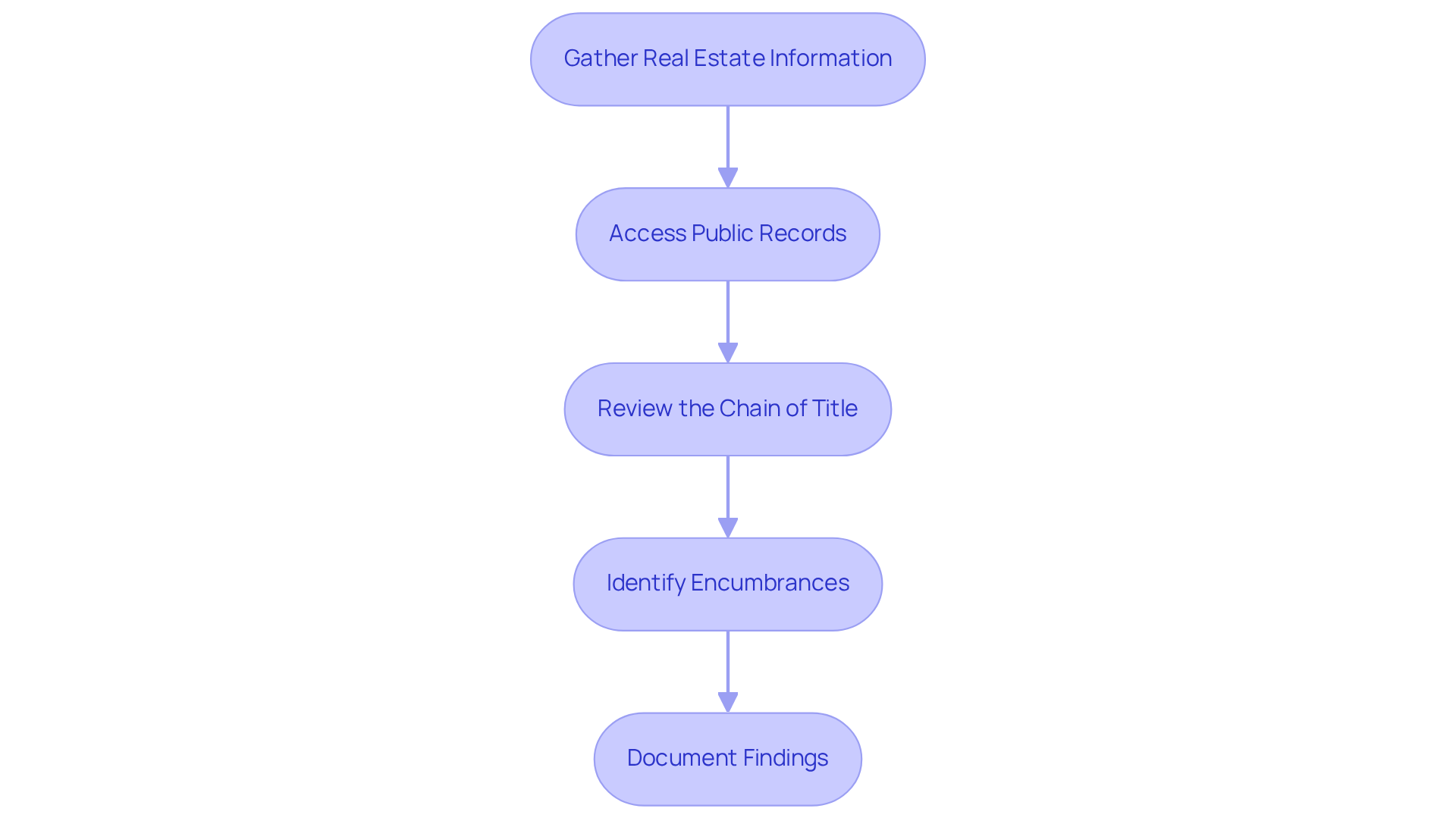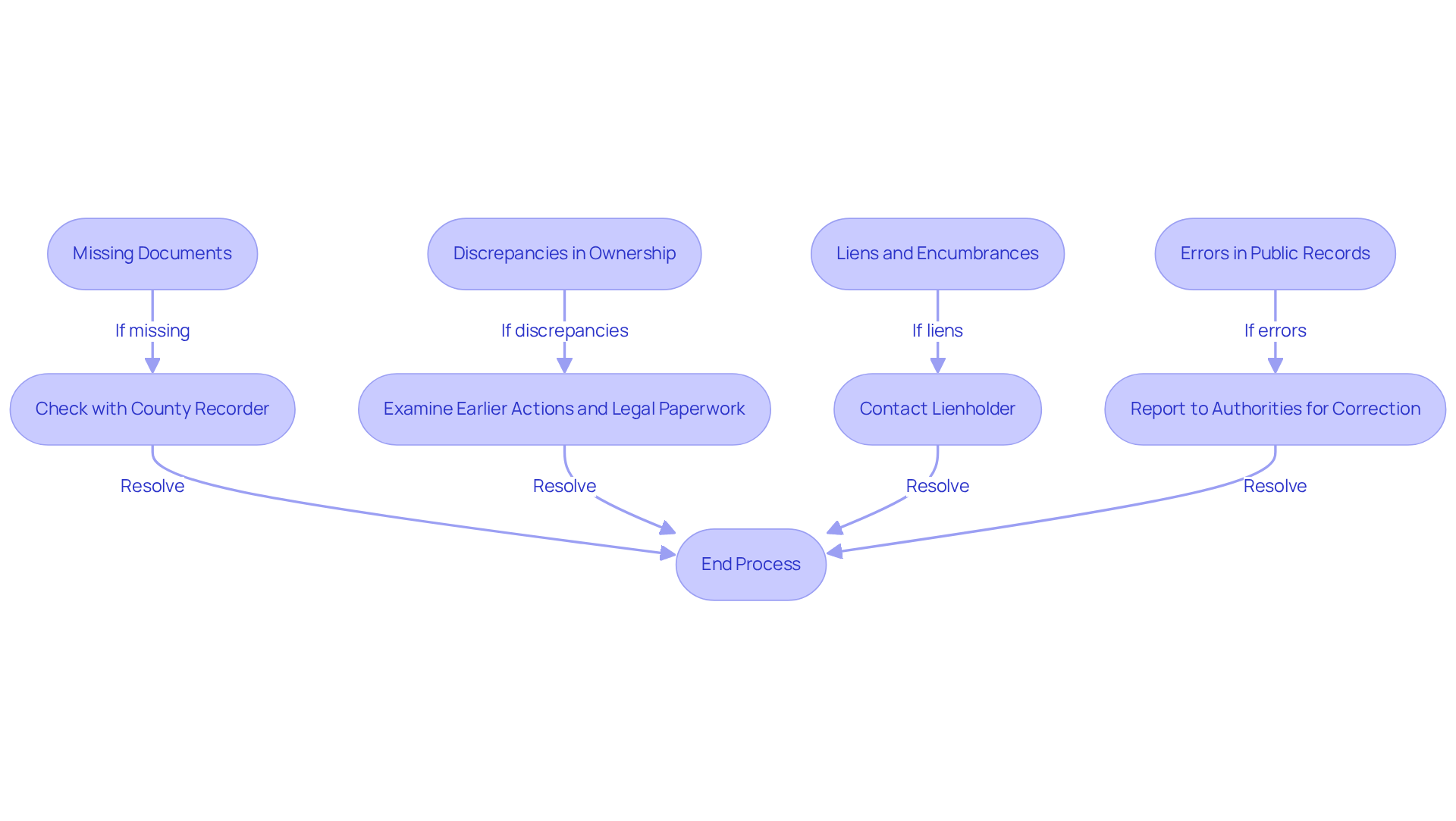Overview
The article delineates three critical steps for title companies to verify ownership:
- Conducting a comprehensive title search
- Troubleshooting common title search issues
- Utilizing advanced technology to enhance the verification process
It underscores the significance of a thorough understanding of the chain of title, public records, and potential encumbrances, which are essential for accurately confirming ownership and ensuring smooth real estate transactions. Furthermore, it is supported by evidence of technological advancements that significantly improve efficiency and accuracy in the verification process.
Introduction
Understanding the intricate process of ownership verification is crucial for title companies, particularly as the real estate landscape becomes increasingly complex. This guide explores essential steps that professionals can take to ensure accurate verification, underscoring the significance of a clear chain of title and the identification of any encumbrances.
However, with common challenges such as missing documents and discrepancies in ownership records presenting significant hurdles, how can title companies streamline their processes? By addressing these issues, companies can mitigate risks and enhance transaction efficiency.
Understand Ownership Verification Basics
Understanding how title companies verify ownership is essential for confirming the legal ownership of a property, encompassing several key concepts.
- Title serves as the legal document that proves ownership, establishing the rights of the property holder.
- Chain of Title refers to the chronological record of title transfers for a real estate asset. A clear and unbroken chain is crucial for validating possession and ensuring that no claims or disputes exist.
- Encumbrances include any claims, liens, or legal rights against the property that may influence title rights, such as mortgages or easements.
Understanding these elements is critical for professionals in the field. As of 2025, approximately 97% of document firms in RON-approved states are employing technology for property verification, indicating a significant shift towards digital solutions in the sector. This technological adoption not only enhances efficiency but also improves accuracy in the verification process.
Recent regulations underscore the importance of comprehensive document verification, ensuring adherence to legal standards. Successful ownership verification methods illustrate how title companies verify ownership by leveraging advanced tools and software that streamline the process, allowing real estate professionals to confirm ownership swiftly and accurately. As industry specialists emphasize, a strong comprehension of ownership and the chain of ownership is essential for reducing risks and facilitating seamless transactions.

Conduct a Comprehensive Title Search
To conduct a comprehensive title search, follow these essential steps:
- Gather Real Estate Information: Collect all relevant details about the asset, including the address, legal description, and parcel number. Precise information is essential for a successful inquiry.
- Access Public Records: Utilize local county recorder's offices or online databases to access public records related to the property. This step is vital, as approximately 90% of title searches rely on public records to confirm ownership and identify any claims, as noted by AFX Research, which has extensive experience in title search services across the U.S.
- Review the Chain of Title: Examine the history of property transfers to ensure there are no gaps or discrepancies. A thorough review helps identify any potential issues that could complicate the transaction.
- Identify Encumbrances: Investigate any liens, mortgages, or other claims against the asset that could affect ownership. Understanding how title companies verify ownership of these burdens is crucial, as they can greatly influence the asset's value and the buyer's financial responsibilities.
- Document Findings: Create a detailed report summarizing your findings, including any issues that need to be addressed before proceeding with the transaction. This documentation is crucial for transparency and can serve as a reference for all parties involved.
The typical timeframe for finishing a property investigation usually spans from 10 to 14 days, based on the intricacy of the property. Employing advanced tools such as Parse AI can greatly improve the efficiency of this process by swiftly extracting pertinent information from lengthy documents, enabling researchers to accomplish their tasks more rapidly and precisely. AFX Research highlights that their expertise and technology can address most title-related problems internally, frequently without postponing real estate transactions.

Troubleshoot Common Title Search Issues
During a document review, several typical problems may arise that necessitate thorough troubleshooting. Effectively addressing these issues is crucial for understanding how title companies verify ownership during title research.
- Missing Documents: When certain documents are unavailable, it is imperative to first check with the county recorder's office for any updates or corrections. Recent statistics indicate that approximately 30% of document searches report missing files, underscoring the importance of diligence in this area.
- Discrepancies in Ownership: When ownership records do not align, further investigation is essential. To trace the chain of ownership, it is necessary to examine earlier actions and legal paperwork, which is how title companies verify ownership. Title professionals emphasize that understanding how title companies verify ownership can help resolve discrepancies early and prevent future legal disputes. As one expert noted, "Addressing discrepancies promptly can save significant time and resources down the line."
- Liens and Encumbrances: Uncovering liens during a property search requires swift action. Contacting the lienholder to negotiate a resolution or ensuring that all liens are cleared before closing is critical. Understanding how title companies verify ownership is vital for recognizing that liens can secure debts against the property and for preserving clear ownership. In complex situations, legal assistance may be required to navigate these issues effectively.
- Errors in Public Records: If errors in public records are encountered, reporting them to the appropriate authorities for correction is essential. This step guarantees that the heading remains clear and free of flaws, as mistakes can lead to considerable financial pressure in the future. Clerical errors, such as typos and misfiled documents, are among the most frequent problems that can complicate property searches.
By proactively addressing these issues, title researchers can streamline their workflows and improve how title companies verify ownership, minimizing delays in property transactions and enhancing overall efficiency.

Conclusion
Understanding the process of ownership verification is essential for title companies; it ensures that real estate transactions are conducted smoothly and legally. By grasping the fundamentals of title, chain of title, and encumbrances, professionals can effectively validate property ownership and mitigate potential disputes. Furthermore, the industry's shift towards digital solutions enhances the accuracy and efficiency of these verifications, making it an essential focus for anyone involved in real estate.
The article outlines a step-by-step approach to conducting a comprehensive title search, emphasizing the importance of:
- Gathering accurate information
- Accessing public records
- Thoroughly reviewing the chain of title
It also highlights common challenges faced during title searches, such as:
- Missing documents
- Discrepancies in ownership
While providing strategies for addressing these issues. By proactively troubleshooting potential problems, title professionals can streamline their processes and uphold the integrity of property transactions.
In conclusion, the significance of ownership verification in real estate cannot be overstated. As the industry continues to evolve with technological advancements, it is crucial for title companies to stay informed about best practices and common issues in title searches. By embracing these strategies, professionals can enhance their operational efficiency, foster trust and transparency in every transaction, and ultimately contribute to a more robust real estate market.
Frequently Asked Questions
What is the purpose of ownership verification in real estate?
Ownership verification is essential for confirming the legal ownership of a property and establishing the rights of the property holder.
What is a title in the context of property ownership?
A title is the legal document that proves ownership of a property, establishing the rights of the property holder.
What does "Chain of Title" refer to?
Chain of Title refers to the chronological record of title transfers for a real estate asset. A clear and unbroken chain is crucial for validating possession and ensuring that no claims or disputes exist.
What are encumbrances in real estate?
Encumbrances are any claims, liens, or legal rights against the property that may influence title rights, such as mortgages or easements.
How is technology impacting ownership verification in the real estate sector?
As of 2025, approximately 97% of document firms in RON-approved states are using technology for property verification, enhancing efficiency and accuracy in the verification process.
Why is comprehensive document verification important?
Comprehensive document verification ensures adherence to legal standards and helps reduce risks in real estate transactions.
What methods do title companies use for ownership verification?
Title companies leverage advanced tools and software that streamline the verification process, allowing real estate professionals to confirm ownership swiftly and accurately.
Why is understanding ownership and the chain of ownership important for real estate professionals?
A strong comprehension of ownership and the chain of ownership is essential for reducing risks and facilitating seamless transactions in the real estate industry.




